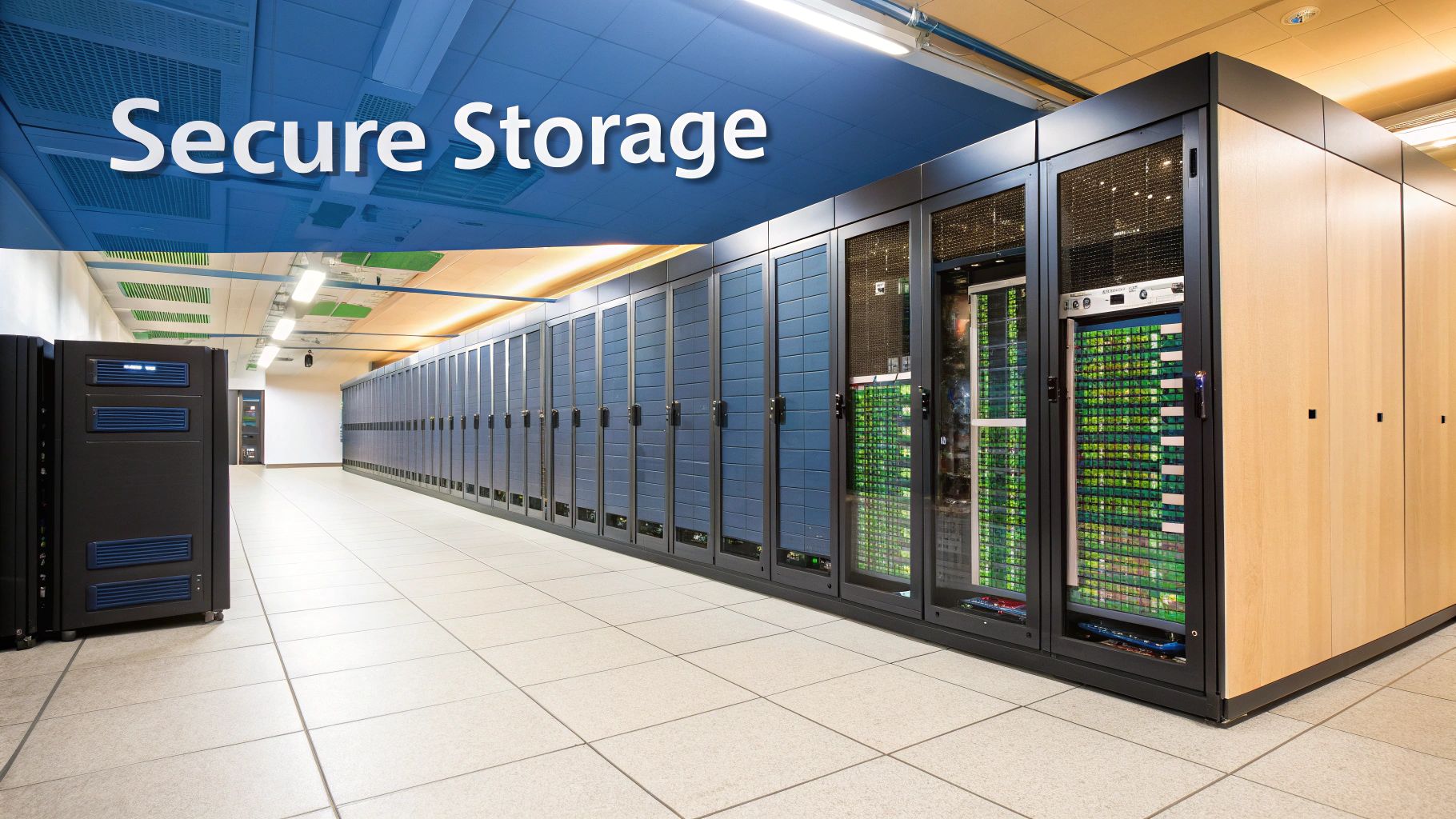7 Proven Data Protection Strategies Every Organization Should Master
Understanding Today's Data Protection Landscape

As organizations collect and store more information than ever before, keeping sensitive data safe has become critical. Cyberattacks targeting valuable information continue to increase in both frequency and complexity. This means businesses must take active steps to protect their data assets and maintain the confidence of customers and partners who trust them with their information.
The Rising Tide of Data Breaches
Recent statistics paint a concerning picture of data security. In 2022, there were 1,774 reported data breaches affecting 422 million individuals - averaging 4.8 breaches every day. The scope of compromised information is equally troubling. These incidents exposed victims' names in 1,560 breaches, social security numbers in 1,143 cases, and medical records in 465 instances. Perhaps most alarming was the 2020 CAM4 breach that exposed over 10 billion records, showing just how massive these incidents can become. For more details, see data privacy statistics.
Why Traditional Security Measures Fall Short
Standard security tools like firewalls and antivirus software no longer provide adequate protection on their own. These measures mainly defend against external threats but don't address risks from inside an organization or sophisticated attacks that slip past basic defenses. The growth of cloud services and remote work has also made it harder to secure network boundaries. Organizations must now think beyond simple perimeter security to implement thorough data protection that works regardless of where information is accessed.
The Importance of a Multi-Layered Approach
Effective data protection requires multiple security measures working together. This includes strict access controls limiting who can view sensitive data, encryption that scrambles information during transmission and storage, and regular backups to maintain business continuity if systems fail. For example, multi-factor authentication adds an extra verification step beyond passwords, making unauthorized access much more difficult. Think of it like having several locks on a door - if one fails, others still keep intruders out. While implementing comprehensive security requires investment, it's essential for safeguarding an organization's future.
Building A Comprehensive Data Protection Framework

Organizations need systematic ways to protect their valuable data assets. A strong data protection framework takes a proactive approach by putting multiple security layers and controls in place before incidents occur. This prevents costly breaches while ensuring business continuity.
Key Elements of a Robust Framework
Creating effective data protection requires several interconnected components working together. Here are the essential building blocks:
- Data Identification and Categorization: Start by mapping out what types of data you have and how sensitive each type is. For example, customer payment details need much stricter controls than marketing materials. This helps focus security efforts where they matter most.
- Data Lifecycle Management: Track and secure data from creation through disposal. Have clear processes for how data should be handled at each stage, following all relevant regulations and best practices.
- Data Backup and Recovery: Maintain regular backups to quickly restore operations if data is lost, corrupted or held hostage by ransomware. Test backups regularly to ensure they work when needed.
- Data Risk Management: Look for security gaps before they can be exploited. Put controls in place like access restrictions, encryption, and anti-malware to address identified risks.
- Data Loss Prevention (DLP): Use specialized tools to stop sensitive information from leaving approved channels. Block unauthorized data transfers through email, file sharing, and other potential leak points.
Implementing Effective Data Governance Policies
Strong governance policies create the foundation for protecting data properly. These policies should clearly spell out:
- Who can access what data and under what conditions
- Individual roles and responsibilities around data security
- How long to retain different types of data
- Steps for securely disposing of data that's no longer needed
Review and update these policies regularly as threats and business needs change.
Access Control and Encryption: Essential Safeguards
Access control and encryption work together as critical security measures. Access control ensures only authorized users can view sensitive data. Encryption scrambles data so it's useless even if stolen. For example, encrypting laptop data protects it if the device is lost or stolen.
Adding multi-factor authentication provides an extra verification step beyond just passwords. This significantly reduces the risk of unauthorized access.
Building a Security-Conscious Culture
Technical controls are only effective when paired with security-aware employees. Regular training helps staff:
- Spot phishing attempts and social engineering tricks
- Follow security best practices in their daily work
- Handle sensitive data appropriately
- Report potential security issues promptly
When organizations combine robust technical safeguards with security-conscious employees, they build a strong defense against data breaches while maintaining stakeholder trust.
Navigating Global Data Protection Regulations
Organizations need clear data protection strategies to safeguard customer information and meet international regulations. Getting compliance right helps build trust and avoid significant penalties. To succeed, companies must create flexible approaches that work across different regions and jurisdictions.
Understanding Key Regulations
The General Data Protection Regulation (GDPR) marked a major shift in how organizations handle personal data when it took effect in 2018. This comprehensive EU law sets strict rules for collecting and using personal information, both within Europe and when transferring data elsewhere. It gives EU citizens important rights over their data, including access and deletion. Companies face serious consequences for violations - up to €20 million or 4% of global revenue. Learn more about the evolution of privacy laws here. Beyond Europe, other key frameworks include the California Consumer Privacy Act (CCPA) in the US and similar laws in Brazil and Japan.
Building a Global Compliance Program
Creating an effective worldwide compliance program requires careful planning and execution. Start by identifying which regulations affect your business based on where you operate and what data you handle. Map out how information flows through your systems and moves between countries. Regular risk reviews help spot potential issues before they become problems.
Practical Strategies for Global Compliance
- Data Mapping: Create detailed documentation showing where and how you store and process data in each region. This provides clarity on what rules apply where.
- Policy Development: Write clear data protection policies that meet the highest standards across all relevant regulations. This creates a strong foundation for compliance everywhere.
- Cross-Border Data Transfers: Use approved methods like Standard Contractual Clauses (SCCs) when moving personal data between countries. This keeps information secure and compliant.
- Documentation: Keep detailed records of how you handle data, manage consent, and respond to privacy requests. This helps prove compliance when needed.
- Monitoring and Auditing: Check data protection practices regularly through internal reviews and formal audits. This helps catch and fix issues early.
- Employee Training: Give staff ongoing training about data protection rules and best practices. This helps prevent mistakes and builds a security-minded culture.
Following these practical steps helps organizations protect data properly, keep customer trust, and stay compliant with complex international regulations. The key is taking a systematic, thorough approach while remaining flexible enough to adapt as requirements change.
Implementing Real-Time Threat Detection And Response

Modern security requires more than just defensive tools - it demands active monitoring and rapid response capabilities to stop threats before they cause major damage. Organizations need to constantly watch their systems for suspicious activity and take immediate action when threats emerge. This proactive stance is essential as cyber attacks grow more complex and sophisticated each day.
Leveraging AI and Machine Learning
Artificial intelligence and machine learning are powerful tools for spotting potential attacks. These technologies analyze system data to identify concerning patterns, like unusual login attempts or suspicious file transfers. This frees up security teams to focus on investigating and responding to the most serious threats. The stakes are high - studies show hackers attempt attacks every 39 seconds on internet-connected systems. Data breaches now cost companies an average of $4.24 million**, with remote work incidents adding over **$1 million more. For more security statistics, see this detailed report.
Building an Effective Incident Response Program
A strong incident response program is vital for handling security events properly. This program outlines specific steps - from isolating compromised systems to restoring data backups. Regular testing through simulated attacks helps ensure the team knows exactly what to do during a real incident. Testing also reveals gaps that need improvement. Without proper incident response procedures, organizations risk prolonged outages and data loss when attacks occur.
Integrating Automated Detection with Human Analysis
While automated tools excel at spotting anomalies, human expertise remains essential for effective security. Security analysts must investigate alerts, determine which threats are legitimate, and decide on appropriate responses. This combination of automation and human judgment provides both rapid detection and careful analysis. Some sophisticated attacks can evade purely automated systems, making human oversight crucial. The most effective security programs seamlessly blend technology and human expertise.
Employee Training And Security Culture Development

Successful data protection depends heavily on employees who understand security and follow best practices consistently. While technical controls are essential, your workforce's security awareness and behaviors make the real difference between strong and weak defenses. Building a security-minded culture requires ongoing effort, but the payoff is significant protection against data breaches.
Building Effective Security Awareness Programs
Good security training engages employees and helps them develop lasting secure habits - much like learning to drive safely requires both knowledge and practice. The key is making the training relevant and memorable.
- Interactive Training: Engage employees with hands-on exercises like phishing simulations and real-world scenarios they might encounter. This helps them recognize and respond to actual threats.
- Role-Based Content: Different teams face different risks. Sales staff need training on client data protection, while IT teams need deeper technical security knowledge. Focus training on each group's specific needs.
- Short, Frequent Sessions: Break training into brief modules that fit easily into the workday. People retain more from regular short sessions than from long, occasional training.
Measuring Program Effectiveness and Driving Continuous Improvement
Like any business program, security awareness efforts need clear metrics to show impact and highlight areas for improvement.
- Track Completion: Monitor how many employees finish required training. Low completion may signal scheduling conflicts or disengaging content.
- Test Knowledge: Use quizzes and assessments to check if employees remember key concepts after training. This reveals topics needing extra focus.
- Run Practice Scenarios: Regular phishing tests and security drills show how well employees apply their training in realistic situations.
Maintaining Long-Term Security Awareness
Building security awareness takes time and consistent reinforcement. The goal is making secure practices feel natural rather than burdensome.
- Simple Reminders: Share quick security tips through email or chat to keep best practices top of mind. For example, monthly security newsletters with practical advice.
- Built-In Security: Make secure actions part of normal workflows, like password strength meters and suspicious email reporting buttons.
- Positive Recognition: Highlight employees who spot threats or follow security procedures well. This encourages others to be security-conscious too.
- Fun Competitions: Add friendly contests and rewards to security training to boost engagement and participation.
When organizations prioritize ongoing security education and positive culture change, employees become a strong defense against data breaches rather than a weakness. This proactive approach creates lasting protection that evolves along with new security challenges.
Future-Proofing Your Data Protection Strategy
Data protection needs to evolve constantly as technology advances and new security threats emerge. A static approach won't keep your information safe for long. You need an adaptable strategy that can handle both current and future challenges.
Emerging Technologies and Their Impact on Security
The security landscape is shifting rapidly with major technological developments. Quantum computing could potentially break today's encryption methods, putting sensitive data at risk. Meanwhile, artificial intelligence is becoming a key tool for both cyber attackers and defenders, creating an ongoing battle of capabilities. Organizations must stay alert and integrate new security solutions as they become available.
Practical Steps for Forward-Looking Protection
Here's how to build security that stands the test of time:
- Adopt Flexible Security Models: Static security frameworks quickly become outdated. Use adaptable approaches that let you quickly respond to new threats - similar to building with modular blocks that you can reconfigure as needed.
- Get Ready for Quantum Computing: Start testing encryption methods that can resist quantum computer attacks. Taking action now will protect you when quantum technology matures.
- Use AI for Better Detection: AI systems can spot subtle attack patterns in vast amounts of data more effectively than human analysts. Add AI-powered tools to strengthen your threat monitoring.
- Reduce Data Exposure: Only collect essential data and spread storage across multiple locations. This limits what attackers can access, like keeping valuables in several secure locations instead of one.
Building an Adaptable Security Framework
Your security strategy needs built-in flexibility to:
- Add New Tools: Be ready to bring in emerging security technologies as they develop
- Counter New Threats: Keep up with the latest attack methods and adjust defenses accordingly
- Match Business Growth: Make sure security measures can expand alongside your organization
Focus on staying agile and proactive while continuously improving your approach. Leading companies are already taking these steps to protect their data both now and in the future.
Looking to enhance your data security and document workflows? Whisperit provides secure AI dictation and text editing that keeps your sensitive information protected. Contact us for a demo.